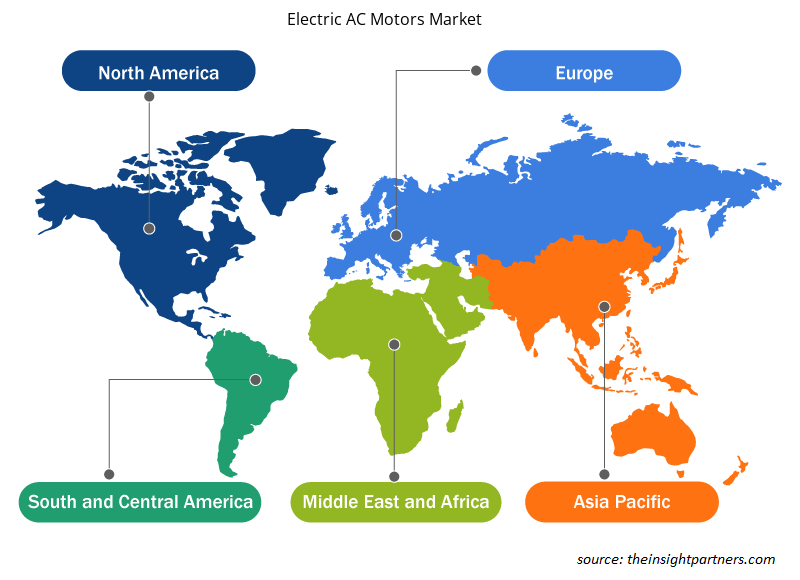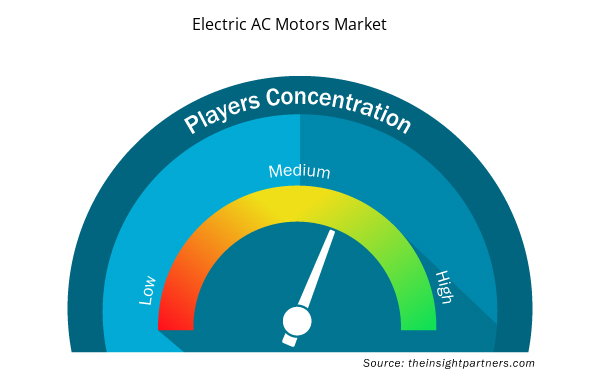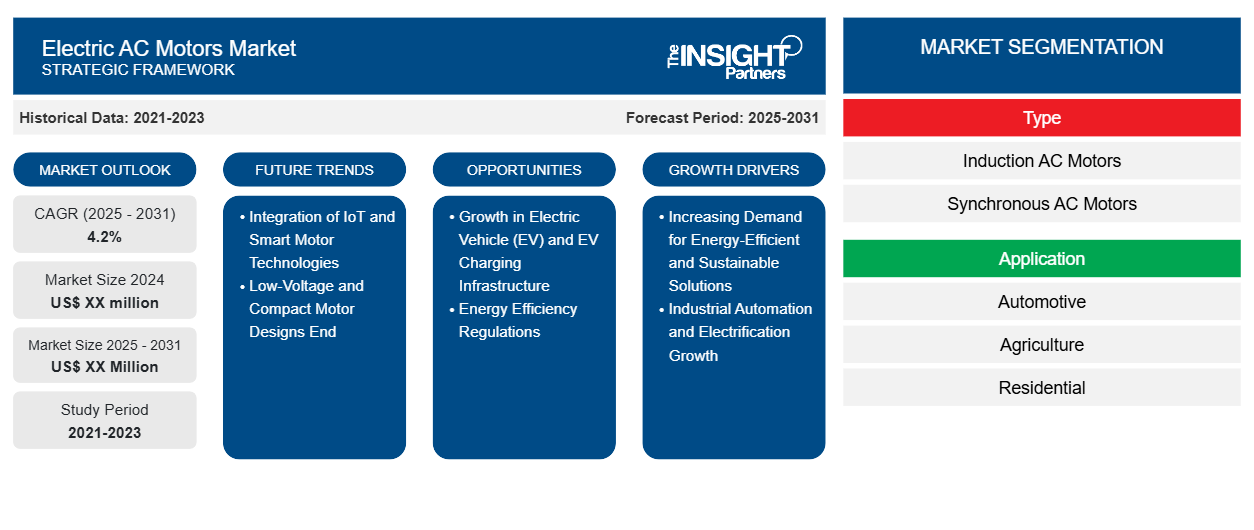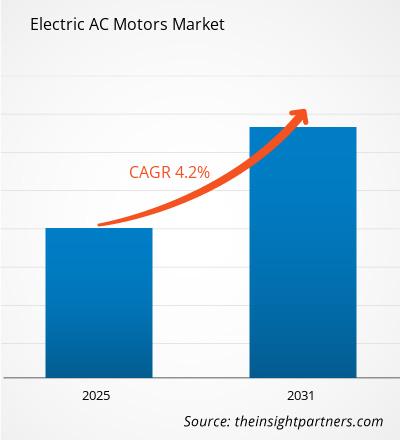Der Markt für elektrische Wechselstrommotoren wird voraussichtlich von 2023 bis 2031 eine durchschnittliche jährliche Wachstumsrate (CAGR) von 4,4 % verzeichnen, wobei die Marktgröße von XX Millionen US-Dollar im Jahr 2023 auf XX Millionen US-Dollar im Jahr 2031 wachsen wird.
Der Bericht ist nach Typ (Induktions-Wechselstrommotoren, Synchron-Wechselstrommotoren) und Anwendung (Automobil, Landwirtschaft, Wohnen, Gewerbe, Industrie, Sonstige) segmentiert. Die globale Analyse ist weiter auf regionaler Ebene und nach wichtigen Ländern aufgeschlüsselt. Der Bericht bietet den Wert in USD für die oben genannte Analyse und Segmente.
Zweck des Berichts
Der Bericht „Markt für elektrische Wechselstrommotoren“ von The Insight Partners soll die aktuelle Situation und das zukünftige Wachstum sowie die wichtigsten Antriebsfaktoren, Herausforderungen und Chancen beschreiben. Dies wird verschiedenen Geschäftspartnern Einblicke geben, wie zum Beispiel:
- Technologieanbieter/-hersteller: Um die sich entwickelnde Marktdynamik zu verstehen und die potenziellen Wachstumschancen zu kennen, damit sie fundierte strategische Entscheidungen treffen können.
- Investoren: Durchführung einer umfassenden Trendanalyse hinsichtlich der Marktwachstumsrate, der finanziellen Marktprognosen und der Chancen entlang der Wertschöpfungskette.
- Regulierungsbehörden: Zur Regulierung von Richtlinien und Überwachungsaktivitäten auf dem Markt mit dem Ziel, Missbrauch zu minimieren, das Vertrauen der Anleger zu bewahren und die Integrität und Stabilität des Marktes aufrechtzuerhalten.
Marktsegmentierung für elektrische Wechselstrommotoren
Typ
- Induktions-Wechselstrommotoren
- Synchrone Wechselstrommotoren
Anwendung
- Automobilindustrie
- Landwirtschaft
- Wohnen
- Kommerziell
- Industrie
- Sonstiges
Passen Sie diesen Bericht Ihren Anforderungen an
Sie erhalten kostenlose Anpassungen an jedem Bericht, einschließlich Teilen dieses Berichts oder einer Analyse auf Länderebene, eines Excel-Datenpakets sowie tolle Angebote und Rabatte für Start-ups und Universitäten.
- Holen Sie sich die wichtigsten Markttrends aus diesem Bericht.Dieses KOSTENLOSE Beispiel umfasst eine Datenanalyse von Markttrends bis hin zu Schätzungen und Prognosen.
Wachstumstreiber auf dem Markt für elektrische Wechselstrommotoren
- Steigende Nachfrage nach Energieeffizienz und Nachhaltigkeit: Da Industrie und Verbraucher zunehmend auf Nachhaltigkeit und die Reduzierung des Energieverbrauchs achten, steigt die Nachfrage nach energieeffizienten Lösungen. Elektrische Wechselstrommotoren sind für ihre hohe Effizienz im Vergleich zu anderen Motortypen bekannt, was sie ideal für Anwendungen in der industriellen Automatisierung, in HLK-Systemen und in Haushaltsgeräten macht. Der globale Vorstoß zur Energieeinsparung sowie strengere Energieeffizienzvorschriften und Nachhaltigkeitsziele treiben die Nachfrage nach elektrischen Wechselstrommotoren in verschiedenen Sektoren an, von der Fertigung bis hin zu Wohnanwendungen.
- Wachstum in der industriellen Automatisierung und Elektrifizierung: Der anhaltende Ausbau der industriellen Automatisierung sowie der allgemeine Trend zur Elektrifizierung in verschiedenen Sektoren (wie Transport, Fertigung und Landwirtschaft) sind ein wichtiger Treiber für den Markt für elektrische Wechselstrommotoren. Wechselstrommotoren sind wesentliche Komponenten in automatisierten Systemen und treiben alles an, von Förderbändern und Roboterarmen bis hin zu Pumpen und Lüftern. Da die Industrie zunehmend automatisierte und elektrifizierte Lösungen einführt, um die Produktivität zu verbessern und Kosten zu senken, steigt die Nachfrage nach zuverlässigen und effizienten elektrischen Wechselstrommotoren weiter.
Zukünftige Trends auf dem Markt für elektrische Wechselstrommotoren
- Integration von IoT und intelligenten Funktionen: Einer der wichtigsten Trends auf dem Markt für elektrische Wechselstrommotoren ist die Integration von Funktionen des Internets der Dinge (IoT), um intelligente Motorlösungen zu ermöglichen. Durch die Einbettung von Sensoren und Konnektivität in Motoren können Hersteller die Leistung überwachen, Wartungspläne verfolgen und die Gesamteffizienz verbessern. IoT-fähige Motoren sind besonders wertvoll in der industriellen Automatisierung, in HLK-Systemen und in intelligenten Geräten, da sie Echtzeiteinblicke liefern und eine vorausschauende Wartung ermöglichen, wodurch Ausfallzeiten reduziert und die Betriebseffizienz verbessert werden. Der Trend zu intelligenten, vernetzten Motoren wird voraussichtlich an Dynamik gewinnen, da die Industrien versuchen, die Produktivität zu verbessern und die Kosten zu senken. Wachstum erneuerbarer Energien und dezentraler Stromerzeugung: Die zunehmende Abhängigkeit von erneuerbaren Energiequellen wie Wind- und Solarenergie treibt die Nachfrage nach elektrischen Wechselstrommotoren an, die wesentliche Komponenten in erneuerbaren Energiesystemen sind. Beispielsweise spielen Wechselstrommotoren in Windkraftanlagen eine entscheidende Rolle bei der Umwandlung mechanischer Energie in elektrische Energie. Da der globale Wandel hin zu erneuerbaren Energien und dezentraler Stromerzeugung fortschreitet, steigt die Nachfrage nach Motoren, die effizient, zuverlässig und langlebig unter rauen Umweltbedingungen sind. Der Trend zu sauberen Energielösungen bietet Herstellern die Möglichkeit, spezielle elektrische Wechselstrommotoren für Anwendungen im Bereich erneuerbarer Energien zu entwickeln.
Marktchancen für elektrische Wechselstrommotoren
- Fortschritte bei Motordesign und Steuerungssystemen: Es gibt erhebliche Möglichkeiten bei der Entwicklung fortschrittlicherer Designs und Steuerungssysteme für elektrische Wechselstrommotoren, insbesondere durch die Integration von IoT- (Internet of Things) und KI-Technologien. Intelligente Motorsysteme, die die Leistung überwachen, den Energieverbrauch optimieren und Echtzeit-Datenanalysen bereitstellen können, erfreuen sich zunehmender Beliebtheit. Durch die Verbesserung des Motordesigns und die Integration intelligenter Steuerungssysteme können Hersteller Produkte mit verbesserter Leistung, Haltbarkeit und Energieeffizienz anbieten. Dieser Trend bietet Unternehmen auf dem Markt für elektrische Wechselstrommotoren eine lukrative Gelegenheit, Produkte der nächsten Generation für industrielle, gewerbliche und private Anwendungen zu entwickeln.
- Zunehmende Verbreitung von Elektrofahrzeugen (EVs) und umweltfreundlichen Technologien: Der Übergang zu Elektrofahrzeugen (EVs) und anderen umweltfreundlichen Technologien bietet erhebliche Wachstumschancen für den Markt für elektrische Wechselstrommotoren. Wechselstrommotoren werden aufgrund ihrer hohen Effizienz und Zuverlässigkeit häufig in Antriebssträngen von Elektrofahrzeugen verwendet. Da die Verbreitung von Elektrofahrzeugen weltweit aufgrund staatlicher Anreize, Umweltvorschriften und sich ändernder Verbraucherpräferenzen zunimmt, gibt es einen wachsenden Markt für Wechselstrommotoren, die auf Elektrofahrzeuge und erneuerbare Energiesysteme wie Wind- und Solarstromerzeugung zugeschnitten sind. Unternehmen, die innovativ sind und spezielle Motoren für diese Anwendungen anbieten können, werden von diesem wachsenden Trend profitieren.
Regionale Einblicke in den Markt für elektrische Wechselstrommotoren
Die regionalen Trends und Faktoren, die den Markt für elektrische Wechselstrommotoren während des Prognosezeitraums beeinflussen, wurden von den Analysten von Insight Partners ausführlich erläutert. In diesem Abschnitt werden auch die Marktsegmente und die Geografie für elektrische Wechselstrommotoren in Nordamerika, Europa, im asiatisch-pazifischen Raum, im Nahen Osten und Afrika sowie in Süd- und Mittelamerika erörtert.

- Erhalten Sie regionale Daten zum Markt für elektrische Wechselstrommotoren
Umfang des Marktberichts über elektrische Wechselstrommotoren
| Berichtsattribut | Details |
|---|---|
| Marktgröße im Jahr 2023 | XX Millionen US-Dollar |
| Marktgröße bis 2031 | XX Millionen US-Dollar |
| Globale CAGR (2023 - 2031) | 4,4 % |
| Historische Daten | 2021-2022 |
| Prognosezeitraum | 2024–2031 |
| Abgedeckte Segmente | Nach Typ
|
| Abgedeckte Regionen und Länder | Nordamerika
|
| Marktführer und wichtige Unternehmensprofile |
|
Marktteilnehmerdichte für elektrische Wechselstrommotoren: Auswirkungen auf die Geschäftsdynamik verstehen
Der Markt für elektrische Wechselstrommotoren wächst rasant, angetrieben durch die steigende Nachfrage der Endnutzer aufgrund von Faktoren wie sich entwickelnden Verbraucherpräferenzen, technologischen Fortschritten und einem größeren Bewusstsein für die Vorteile des Produkts. Mit steigender Nachfrage erweitern Unternehmen ihr Angebot, entwickeln Innovationen, um die Bedürfnisse der Verbraucher zu erfüllen, und nutzen neue Trends, was das Marktwachstum weiter ankurbelt.
Die Marktteilnehmerdichte bezieht sich auf die Verteilung der Firmen oder Unternehmen, die in einem bestimmten Markt oder einer bestimmten Branche tätig sind. Sie gibt an, wie viele Wettbewerber (Marktteilnehmer) in einem bestimmten Marktraum im Verhältnis zu seiner Größe oder seinem gesamten Marktwert präsent sind.
Die wichtigsten auf dem Markt für elektrische Wechselstrommotoren tätigen Unternehmen sind:
- ABB Limited
- AMETEK.Inc
- ASMO CO.LTD.
- Baldor Electric Company
- Elektro Frank
Haftungsausschluss : Die oben aufgeführten Unternehmen sind nicht in einer bestimmten Reihenfolge aufgeführt.

- Überblick über die wichtigsten Akteure auf dem Markt für elektrische Wechselstrommotoren
Wichtige Verkaufsargumente
- Umfassende Abdeckung: Der Bericht deckt die Analyse der Produkte, Dienste, Typen und Endbenutzer des Marktes für elektrische Wechselstrommotoren umfassend ab und bietet einen ganzheitlichen Überblick.
- Expertenanalyse: Der Bericht basiert auf dem umfassenden Verständnis von Branchenexperten und Analysten.
- Aktuelle Informationen: Der Bericht stellt durch die Abdeckung aktueller Informationen und Datentrends Geschäftsrelevanz sicher.
- Anpassungsoptionen: Dieser Bericht kann angepasst werden, um spezifische Kundenanforderungen zu erfüllen und die Geschäftsstrategien optimal anzupassen.
Der Forschungsbericht zum Markt für elektrische Wechselstrommotoren kann daher dabei helfen, die Branchensituation und Wachstumsaussichten zu entschlüsseln und zu verstehen. Obwohl es einige berechtigte Bedenken geben kann, überwiegen die allgemeinen Vorteile dieses Berichts tendenziell die Nachteile.
- Historische Analyse (2 Jahre), Basisjahr, Prognose (7 Jahre) mit CAGR
- PEST- und SWOT-Analyse
- Marktgröße Wert/Volumen – Global, Regional, Land
- Branche und Wettbewerbsumfeld
- Excel-Datensatz



Report Coverage
Revenue forecast, Company Analysis, Industry landscape, Growth factors, and Trends

Segment Covered
This text is related
to segments covered.

Regional Scope
North America, Europe, Asia Pacific, Middle East & Africa, South & Central America

Country Scope
This text is related
to country scope.
Häufig gestellte Fragen
The report can be delivered in PDF/PPT format; we can also share excel dataset based on the request
Some of the customization options available based on the request are an additional 3-5 company profiles and country-specific analysis of 3-5 countries of your choice. Customizations are to be requested/discussed before making final order confirmation# as our team would review the same and check the feasibility
The Electric AC Motors Market is estimated to witness a CAGR of 4.4% from 2023 to 2031
The major factors driving the Electric AC Motors market are Industrial Automation and Robotics and Rising Demand for Energy Efficiency.
Growing Electrification of Transportation is anticipated to play a significant role in the global Electric AC Motors market in the coming years
Trends and growth analysis reports related to Electronics and Semiconductor : READ MORE..
1. ABB Limited
2. AMETEK.Inc
3. ASMO CO.LTD.
4. Baldor Electric Company
5. Franklin Electric
6. Johnson Electric
7. Kirloskar Electric Company
8. Mordor Intelligence
9. Rockwell Automation, Inc.
10. Siemens AG
The Insight Partners performs research in 4 major stages: Data Collection & Secondary Research, Primary Research, Data Analysis and Data Triangulation & Final Review.
- Data Collection and Secondary Research:
As a market research and consulting firm operating from a decade, we have published and advised several client across the globe. First step for any study will start with an assessment of currently available data and insights from existing reports. Further, historical and current market information is collected from Investor Presentations, Annual Reports, SEC Filings, etc., and other information related to company’s performance and market positioning are gathered from Paid Databases (Factiva, Hoovers, and Reuters) and various other publications available in public domain.
Several associations trade associates, technical forums, institutes, societies and organization are accessed to gain technical as well as market related insights through their publications such as research papers, blogs and press releases related to the studies are referred to get cues about the market. Further, white papers, journals, magazines, and other news articles published in last 3 years are scrutinized and analyzed to understand the current market trends.
- Primary Research:
The primarily interview analysis comprise of data obtained from industry participants interview and answers to survey questions gathered by in-house primary team.
For primary research, interviews are conducted with industry experts/CEOs/Marketing Managers/VPs/Subject Matter Experts from both demand and supply side to get a 360-degree view of the market. The primary team conducts several interviews based on the complexity of the markets to understand the various market trends and dynamics which makes research more credible and precise.
A typical research interview fulfils the following functions:
- Provides first-hand information on the market size, market trends, growth trends, competitive landscape, and outlook
- Validates and strengthens in-house secondary research findings
- Develops the analysis team’s expertise and market understanding
Primary research involves email interactions and telephone interviews for each market, category, segment, and sub-segment across geographies. The participants who typically take part in such a process include, but are not limited to:
- Industry participants: VPs, business development managers, market intelligence managers and national sales managers
- Outside experts: Valuation experts, research analysts and key opinion leaders specializing in the electronics and semiconductor industry.
Below is the breakup of our primary respondents by company, designation, and region:

Once we receive the confirmation from primary research sources or primary respondents, we finalize the base year market estimation and forecast the data as per the macroeconomic and microeconomic factors assessed during data collection.
- Data Analysis:
Once data is validated through both secondary as well as primary respondents, we finalize the market estimations by hypothesis formulation and factor analysis at regional and country level.
- Macro-Economic Factor Analysis:
We analyse macroeconomic indicators such the gross domestic product (GDP), increase in the demand for goods and services across industries, technological advancement, regional economic growth, governmental policies, the influence of COVID-19, PEST analysis, and other aspects. This analysis aids in setting benchmarks for various nations/regions and approximating market splits. Additionally, the general trend of the aforementioned components aid in determining the market's development possibilities.
- Country Level Data:
Various factors that are especially aligned to the country are taken into account to determine the market size for a certain area and country, including the presence of vendors, such as headquarters and offices, the country's GDP, demand patterns, and industry growth. To comprehend the market dynamics for the nation, a number of growth variables, inhibitors, application areas, and current market trends are researched. The aforementioned elements aid in determining the country's overall market's growth potential.
- Company Profile:
The “Table of Contents” is formulated by listing and analyzing more than 25 - 30 companies operating in the market ecosystem across geographies. However, we profile only 10 companies as a standard practice in our syndicate reports. These 10 companies comprise leading, emerging, and regional players. Nonetheless, our analysis is not restricted to the 10 listed companies, we also analyze other companies present in the market to develop a holistic view and understand the prevailing trends. The “Company Profiles” section in the report covers key facts, business description, products & services, financial information, SWOT analysis, and key developments. The financial information presented is extracted from the annual reports and official documents of the publicly listed companies. Upon collecting the information for the sections of respective companies, we verify them via various primary sources and then compile the data in respective company profiles. The company level information helps us in deriving the base number as well as in forecasting the market size.
- Developing Base Number:
Aggregation of sales statistics (2020-2022) and macro-economic factor, and other secondary and primary research insights are utilized to arrive at base number and related market shares for 2022. The data gaps are identified in this step and relevant market data is analyzed, collected from paid primary interviews or databases. On finalizing the base year market size, forecasts are developed on the basis of macro-economic, industry and market growth factors and company level analysis.
- Data Triangulation and Final Review:
The market findings and base year market size calculations are validated from supply as well as demand side. Demand side validations are based on macro-economic factor analysis and benchmarks for respective regions and countries. In case of supply side validations, revenues of major companies are estimated (in case not available) based on industry benchmark, approximate number of employees, product portfolio, and primary interviews revenues are gathered. Further revenue from target product/service segment is assessed to avoid overshooting of market statistics. In case of heavy deviations between supply and demand side values, all thes steps are repeated to achieve synchronization.
We follow an iterative model, wherein we share our research findings with Subject Matter Experts (SME’s) and Key Opinion Leaders (KOLs) until consensus view of the market is not formulated – this model negates any drastic deviation in the opinions of experts. Only validated and universally acceptable research findings are quoted in our reports.
We have important check points that we use to validate our research findings – which we call – data triangulation, where we validate the information, we generate from secondary sources with primary interviews and then we re-validate with our internal data bases and Subject matter experts. This comprehensive model enables us to deliver high quality, reliable data in shortest possible time.


 Holen Sie sich ein kostenloses Muster für diesen Bericht
Holen Sie sich ein kostenloses Muster für diesen Bericht